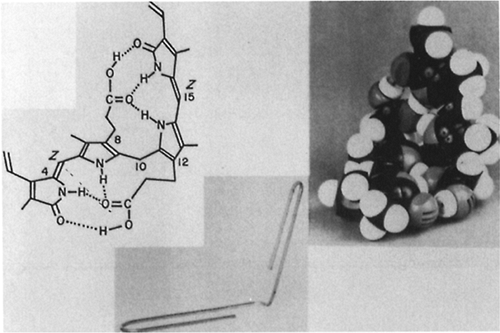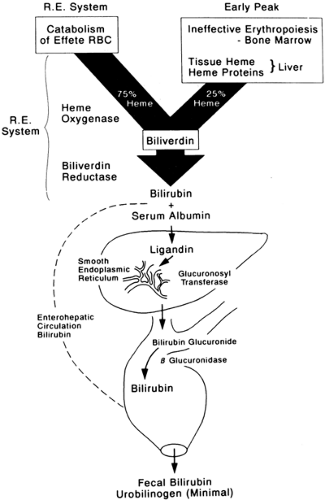Neonatal Bilirubin Metabolism
Bilirubin Production
The normal destruction of circulating erythrocytes accounts for about 75% of the daily bilirubin production in the newborn. Senescent erythrocytes are removed and destroyed in the reticuloendothelial system, where the heme is catabolized and converted to bilirubin (Fig. 35-5). The catabolism of 1 g of hemoglobin yields 35 mg of bilirubin.
A significant contribution (25% or more) to the daily production of bilirubin in the neonate comes from sources other than effete erythrocytes (see Fig. 35-5). This bilirubin consists of two major components:
A nonerythropoietic component resulting from the turnover of nonhemoglobin heme protein and free heme, primarily in the liver.
An erythropoietic component arising primarily from ineffective erythropoiesis and the destruction of immature erythrocyte precursors, either in the bone marrow or soon after release into the circulation.
Transport and Hepatic Uptake of Bilirubin
Once bilirubin leaves the reticuloendothelial system, it is transported in the plasma and bound reversibly to albumin. Unconjugated bilirubin is bound tightly to albumin at a primary (high-affinity) binding site as well as a secondary (low-affinity) site. Because binding affinity at the primary binding site is 107 to 108 L/mol (17), the concentrations of free or unbound bilirubin in plasma are very low, even in the presence of significant hyperbilirubinemia. (The magnitude of the affinity constant was recently questioned (18).) At pH 7.4, the solubility of bilirubin is very low (about 4 nmol/L [0.24 mg/dL]).
TABLE 35-1 FETAL BILIRUBIN METABOLISM | |
|---|---|
|
The parenchymal cells of the liver have a selective and highly efficient capacity for removing unconjugated bilirubin from the plasma. When the bilirubin-albumin complex reaches the plasma membrane of the hepatocyte, a proportion of the bilirubin, but not the albumin, is transferred across the cell membrane into the hepatocyte, a process that potentially involves four different transport proteins (3). In the hepatocyte, bilirubin is bound principally to ligandin and possibly other cytosolic-binding proteins (Fig. 35-6) (3). A network of intracellular microsomal membranes may also play an important role in the transfer of bilirubin within the cell and to the endoplasmic reticulum (3,5).
Stay updated, free articles. Join our Telegram channel

Full access? Get Clinical Tree





